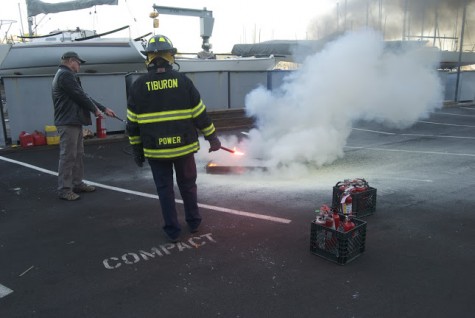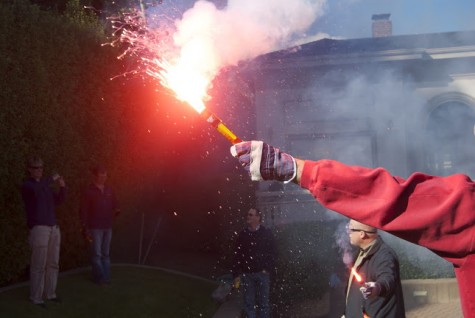Safety at Sea
Oh well – well done – Spinnaker Cup
Unfortunately a weather window has opened for me to take the big blue boat south to Long Beach so instead of flying out the sail on 40 Degrees in Rhode Island at the Atlantic Cup I have stayed here in Mill Valley for the weekend. The boat is ready to go and we are waiting for the tug to get up the coast – she is now off Monterey. This also meant I wasn’t able to do Spinnaker Cup. However, Racing Yacht Management client Tiburon came 1st in division and 3rd overall. Well done guys. The course record was broken and it was a wild ride downwind by all accounts. Wish I didn’t miss it. RYM spent the week prepping the boat to comply with the offshore rules including category 2 ISAF for the upcoming Coastal Cup.
The race council at SFYC did a superb job of on the water pre start safety checks including ensuring that all crew were wearing lifejackets with crotch straps attached and being worn. An entire crew had to be reminded that crotch straps in their bags were not of use should they fall overboard. Another crew had forgotten their lifesling so had to quickly return to their dock to retrieve theirs. Thank you SFYC race volunteers for encouraging safety offshore.
One of the boats with three SFYC ISAF trained crew aboard had a MOB off Pigeon Point and recovered the person in 5 minutes. They credit the training to safely recovering the MOB. Brought a smile to my face and makes all the volunteer hours well worth it.
Artemis tragedy AC72
In response to the numerous forum posts online Artemis racing released the following statement
‘Artemis Racing is in the process of conducting a thorough review and analysis of this week’s accident. As a part of this review, Artemis Racing is sharing and exchanging data and information with concurrent work being performed by America’s Cup and the San Francisco Police Department. Until this process is complete, any conclusions being made about the events that led to the boat’s capsizing and its tragic outcome are pure speculation. Out of respect for Bart’s memory and his family, we ask that the broader sailing community and others reserve judgment until all the facts are known, and not persist in unnecessary rumor. We again thank everyone for their continued support and thoughts during this difficult time.’
There are only a handful of sailors in the world that know what it is like to sail these boats and an internal review by the people who understand the monsters is the only way to do it. The multitude of posts are pure speculation, as is what I am about to write. I have been asked what I think went wrong. I have never sailed these boats and never will I have no knowledge of the conditions aboard the boat. However, there are a few things that I believe will be reviewed in the accident investigations.
1) The engineering/scantlings of the boat.
2) The issue of entrapment – it might be found that ironically having no flotation device is a safer option than having any. The type of knives on the crew members body.
3) How to get larger amounts of emergency air aboard the boats. There is a problem with the boats being so fast that rescue divers might not be able to get there quickly enough. Teams might also need as many rescue divers as sailors to make sure every sailor is gotten to quickly.
4) Development of a single standard operating procedure for crashes followed by all teams. There are a lot of safety measures in place so maybe there are already enough and the procedure wasn’t at fault but I am sure that will be investigated so the all the teams learn.
Maybe infrared cameras would be more efficient at finding sailors quickly instead of a search. However, I am not an expert and I do know water shows up as black so maybe that wouldn’t work. In the below picture you can clearly see my outline when I was helping during thermal scanning of Darling two weeks ago.
One year anniversary written by Bryan Chong
There’s nothing in life more absolutely devastating than the loss of a loved one. It creates a sudden vacancy once occupied by a meaningful connection, awakens us to our own mortality, and forces us to evaluate who we are, what we’ve done and where we’re headed. For the family, friends and survivors, the April 14, 2012 Low Speed Chase accident at the Farallones changed our lives forever.
Alexander Graham Bell said, “When one door closes another door opens; but we often look so long and so regretfully upon the closed door that we do not see the ones which open for us.”
The door that opened for me catapulted me out of my old life and into a new one. It made me reflect on the decisions I’ve made in life and led me to readjust my priorities. It motivated me to stop procrastinating on things I’d do when I had “enough time.” Instead of returning to work, I went on the road with my wonderful wife and infant son. We spent the summer driving 10,000 miles in our yellow Westy Vanagon around the West Coast visiting friends and places I’d always longed to see – Yellowstone, the Tetons, Glacier, Pikes Peak, Telluride and Mt. Rushmore, just to name a few. I finally saw a concert at Red Rocks and a rodeo in South Dakota.
Then in September, instead of going home like responsible adults, we flew to Europe and kept adventuring until we ran out of good weather. All journeys eventually end, and in late January we finally came back to Marin. The trip afforded me the priceless chance to spend a year bonding with my wife and son. It also gave me time to reflect on life, the accident and those I’d lost. It was the trip of a lifetime and I wish I could have shared it with all my Low Speed Chase crewmates.
Not a day passes that I don’t think about what went wrong that day at the Farallones and what can be done to prevent something like this from happening again. I was by no means an expert in safety before the accident, but since I’ve been home numerous sailing groups have invited me to share my thoughts on this topic. I always bring my tether and lifejacket with me to emphasize the basics, but I prefer to focus on the fundamental concept that safety only exists when everyone becomes a leader.
Safety leadership isn’t always easy. It takes a willingness to speak up when others don’t. It’s choosing the safety of yourself and your crewmates over pride, appearance, comfort, costs or an engraved silver cup. It’s leadership by example and can be as simple as showing up early to make sure the safety equipment’s primed, double checking a teammate’s PFD cartridge and tether, tossing your favorite sailing hat in the water to force an MOB exercise, buying your friend a Spinlock lifejacket for their birthday, or setting the expectation that you’ll only crew on boats that take safety seriously. It’s investing in yourself by attending training, sharing what you learned with others, and following through when on the water.
Over the past year, I’ve learned that sailors aren’t the only ones shifting their attention to developing a better safety culture. Tuesday morning, I spoke to the 200 person executive leadership team at PG&E, our local power company. Last year they lost five people to accidents that might have been prevented with the proper use of safety equipment.
I now routinely find myself in safety discussions in which I’m called upon to offer my opinion. I’m still not an expert on all the safety practices, but I do see three areas where we can start focusing.
1. Resolve to be a leader on safety issues. You don’t need to own a boat or be the most experienced sailor. You only need to care about the people aboard.
2. Take a sailing safety class. I recommend finding an interactive one with a small class size that requires attendees to calculate minimum depths using wave forecasts, set off flares, cut rigging, extinguish fires and enter the water with full gear.
3. If you’re in a leadership position for a yacht club or sailing team, recruit a safety instructor to host a seminar for your people.
In 2007, Ashley Perrin and Paul Cunningham, who both specialize in preparing boats for offshore sailing, attempted to host an ISAF certified safety training class. Not enough people registered. Fast forward to today. In the 12 months since the Low Speed Chase accident, they’ve hosted seven classes at the San Francisco Yacht Club, all filled to capacity. Are we evolving as a sailing community? I’d like to believe we are.
A door has opened for sailors to embrace safety. Many have already walked through that door and taken leadership roles on their boats. I’ve seen others pulled through by spouses demanding they attend a safety class before their next ocean race.
This weekend, as we remember those we lost at the Farallones, let’s also keep in mind that this is our moment to cement a culture of safety by continuing to invest in training and equipment that will save lives. I truly wish for the memory of Alan, Marc, Jordan, Alexis and Elmer to be the spark that transforms this community of sailors.
Be safe.
Bryan Chong
bryan@chonger.com
Choosing a life raft
The rescue early last week of Alain Delord, the French single-hander whose boat was dismasted and holed Jan. 18 in the Southern Ocean, after he spent three days in a life raft offers a graphic reminder of the importance of choosing a raft that matches your voyage.
In the age of EPIRBs (Emergency Position Indicating Beacons), it’s easy to lulled into thinking that prolonged life raft ordeals like the one described by Steve Callahan in his classic tale “Adrift” are a thing of the past. Had it not been for the assistance of the Australian Maritime Safety Authority, who dropped Delord a better raft with food, water, and a survival suit, the 63-year-old singlehander might not be alive today.
Delord was eventually picked up by a cruise ship that detoured more than
700 miles to rescue him.
Life raft survival kits used by the recreational yachting community can generally be divided into five categories based, in part, on the distance in miles the yacht will be sailing from shore. Types of emergency survival packs include ISO Pack I, ISO Pack II, SOLAS B Pack, Offshore Pack (Type E), and Coastal Pack. — Practical Sailor, read on:
http://www.practical-sailor.com/blog/-10985-1.html
Safety at Sea courses again – in pictures
We ran another Safety and Sea course at SFYC on 10-11th November. There will be a repeat 17-18th. In the meantime we have VHF and radar courses running in the weekday evenings.
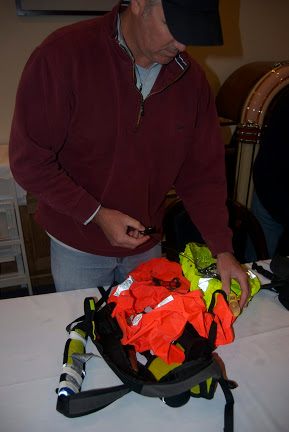
How does this go back together. Getting to know your lifejacket… it is pretty important.
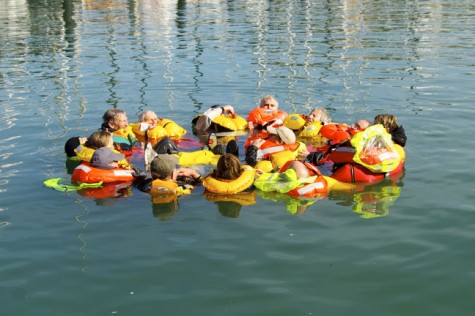 Group hug – warmer, more visible and less likely to get lost
Group hug – warmer, more visible and less likely to get lost
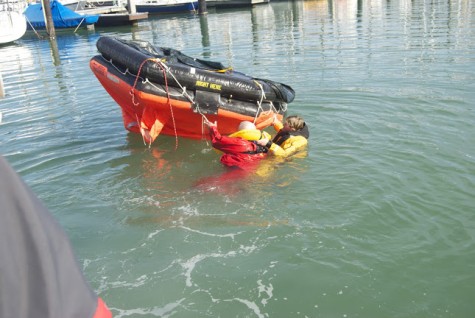
Turn that liferaft back upright.
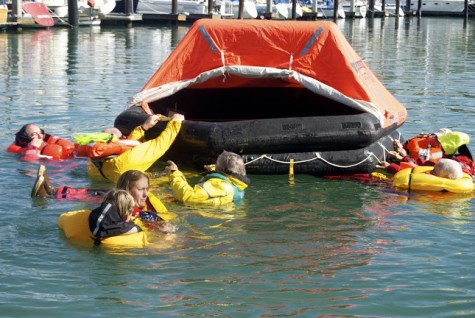 Biggest and strongest in first with people holding down the back of the raft. You need the biggest to help pull in the woman and children.
Biggest and strongest in first with people holding down the back of the raft. You need the biggest to help pull in the woman and children.
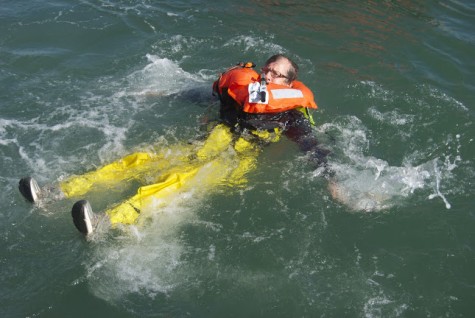 Keep those boots on. Water inside weighs the same as water outside they won’t drag you down… in fact his feet are floating.
Keep those boots on. Water inside weighs the same as water outside they won’t drag you down… in fact his feet are floating.
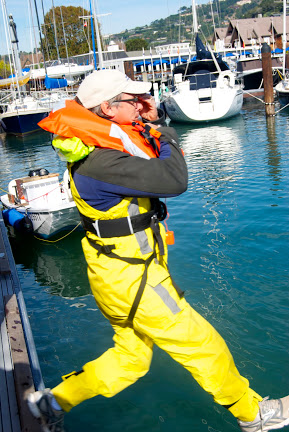 Safely entering the cold water of SF Bay.
Safely entering the cold water of SF Bay.
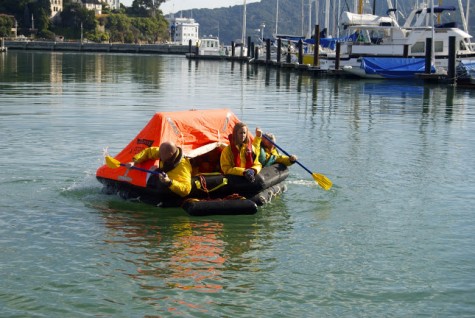
Row row row your liferaft! Getting used to the liferaft… Photo by Paige Brooks
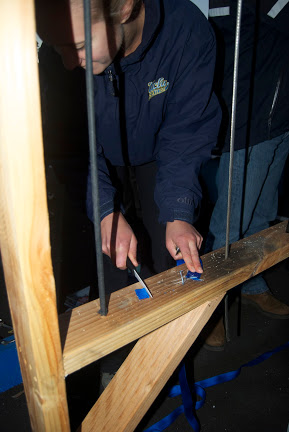
The wonder of ceramic knives from bed bath and beyond! Photo by Paige Brooks
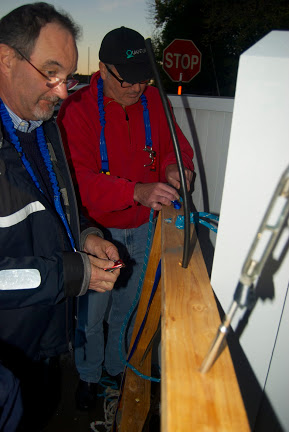
Does your emergency knive work? What type of tools do you carry for cutting your rigging? Where do you try to cut your rigging?
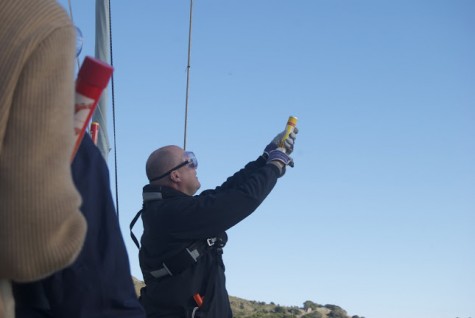
Photo by Paige Brooks
Setting off a rocket flare. Be careful of the recoil and wear gloves!
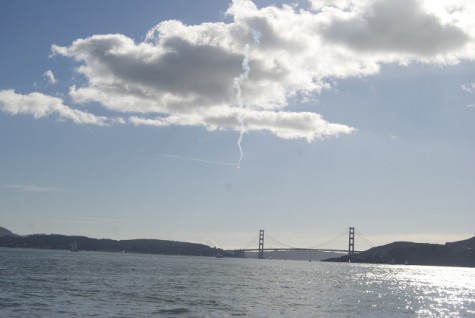
Photo by Paige Brooks
Thank you to George Brewster owner of Black Swan for lending us his boat last minute. If he hadn’t we wouldn’t have been able to do the rocket flares which was a valuable lesson for all involved.
Photo by Paige Brooks
So tell me who wants the SOLAS flare and who wants the non SOLAS flare!
New NorCal Minimum Safety Requirements Discussion
The Northern California Offshore Racing Council Safety Committee has posted a draft of the minimum equipment requirements for offshore races and is inviting comments.
http://www.latitude38.com/lectronic/lectronicday.lasso?date=2012-11-05#Story2 No
Shallow water wave training
Someone advised me of this great shallow water wave training that is available online. You have to register but it is worth it.
There is a National Weather service on-line seminar specifically on Shallow Water Wave behavior at: http://www.meted.ucar.edu/marine/SWW/ . There are also several other more advanced wave seminars available on MetEd.
Don’t play around with your laser flare…
During the May/June Sea Survival seminars we put on at SFYC we showed people a laser flare which is what I keep in my grab bag. We pointed out that planes/helos don’t like them pointed in their face. Check out this story there are heavy fines associated with doing this.
Low Speed Chase Report
US Sailing has published the report into the Low Speed Chase accident. It can been see at http://media.ussailing.org/AssetFactory.aspx?vid=18654



